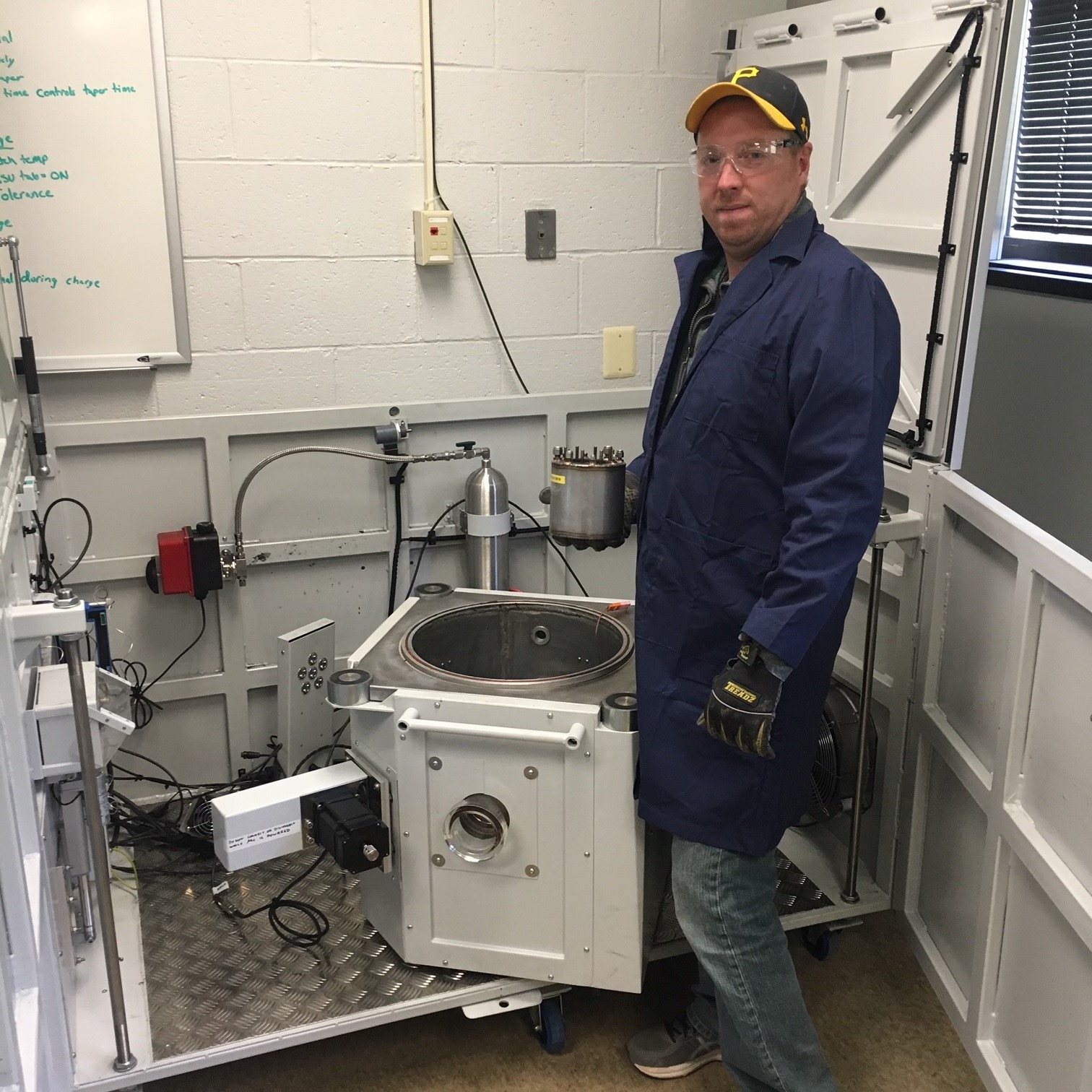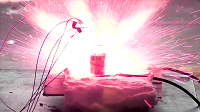Mining Project: Mitigating Fire and Explosion Hazards of Lithium-ion Batteries
| Principal Investigator |
|
|---|---|
| Start Date | 10/1/2018 |
| End Date | 9/30/2022 |
| Objective |
To address the significant knowledge gap that manufacturers and responders have in maintaining safe underground mining vehicle battery systems in relation to battery thermal management and fire response. |
| Topic Areas |
Research Summary
Battery thermal management presents a significant gap in the knowledge that manufacturers need to maintain safe, reliable underground mining vehicle battery systems. Emergency responders need to understand the characteristics of lithium-ion (Li-ion) battery fires and appropriate suppression agents. Li-ion batteries have the potential to create pressurized explosions within explosion-proof or flameproof battery enclosures.
Mining vehicle manufacturers are quickly developing battery electric vehicles (BEVs) powered by Li-ion batteries as an alternative to diesel-powered vehicles. Given the relatively high energy density of Li-ion batteries, the Global Mining Guidelines (GMG) Group reports that Li-ion batteries are currently the most common battery of choice for new BEV applications. The noise, heat, and exhaust generated from diesel engines negatively affect the underground work environment, and diesel emissions are known to pose a health hazard to workers. The benefits of employing BEVs are arguably greater for underground mining than for any other industry.
Despite their benefits, the introduction of new technologies may create the potential for unintended adverse consequences. Li-ion batteries are made from flammable materials and have the potential to introduce fire and explosion hazards from failure modes that may ignite the battery (Figure 1). Further, it is necessary to understand the potential for a large battery fire and the related rescue-ability of personnel. Depending on the battery chemistry, uncommon gases such as hydrogen fluoride could be released into the mine atmosphere should a battery fire or explosion occur. In addition, there are specialized issues associated with fighting a Li-ion battery fire that should be identified to protect fire-fighters and mine rescue personnel from harm. Finally, Mine Safety and Health Administration (MSHA) Approval and Certification personnel have questions about the potential for pressurized explosions within explosion-proof enclosures containing Li-ion batteries in gassy mines, as identified by previous NIOSH research. The NIOSH Mining Program has the specialized equipment and expertise needed to study the unique fire and explosion hazards posed by Li-ion batteries in the underground mining environment.
To address the above issues, this project has two research aims:
(1) Characterize a battery fire in Li-ion battery-powered mining equipment to determine appropriate fire suppression agents/systems and to develop ventilation recommendations for preventing smoke and toxic gas spread in a mine.
(2) Characterize factors that influence Li-ion battery ignition pressures within sealed enclosures to develop design recommendations for explosion-proof or flameproof battery enclosures.

NIOSH technician with accelerating rate calorimeter (ARC).
The research approach for this project includes a laboratory-scale study using an accelerating rate calorimeter (ARC) and larger-scale battery module tests in a fire test chamber. Gas samples will be analyzed by a contracting laboratory and major gases from the thermal runaway will be identified. Different fire detection techniques and fire suppression agents will be examined for the early detection and extinguishment of the battery fire. Li-ion battery ignition pressures within sealed enclosures are dependent on the battery chemistry, amount of confinement, state of charge, and ambient atmosphere in the enclosure. The ARC will be used for a parametric study to assess the impacts of these variables on ignition pressures. Samples of selected Li-ion cells will be sent to a contracting laboratory for compositional analyses of the anode, cathode, electrolyte, and separator materials.
The knowledge generated by the research will impact fire safety and explosion protected equipment design guidelines and requirements prepared by MSHA, the GMG Group, Underwriters Laboratories (UL), and the International Electrotechnical Commission (IEC). The GMG Group develops recommended practices for BEVs in underground mining with provisions for fire safety. MSHA, UL, and the IEC develop requirements or standards for explosion-proof or flameproof battery enclosures. A mining vehicle manufacturer has also expressed interest in collaborating with NIOSH researchers to study thermal behaviors of Li-ion battery modules that the manufacturer is developing.
Related Publications
Rayyan N, Brown C, Dubaniewicz T H (2023). Thermal runaway of LTO and NCA lithium-ion batteries in a sealed enclosure containing methane. SME Annual Meeting Preprint 23-043, Denver CO, March 1.
Tang W, Yuan L, Thomas R, Soles J (2023). Comparison of fire suppression techniques on lithium-ion battery pack fires. SME Annual Meeting Preprint 23-006, Denver, CO, March 1.
Dubaniewicz TH, Barone TL, Brown CB, Thomas RA (2022). Comparison of thermal runaway pressures within sealed enclosures for nickel manganese cobalt and iron phosphate cathode lithium-ion cells. Journal of Loss Prevention in the Process Industries 76:104739.
Rayyan N, Dubaniewicz TH, Yuan L, Brown C, Soles J, Thomas R (2022). Lithium-ion battery thermal runaway in a methane-air environment. SME Annual Meeting Feb. 27 - Mar. 02, 2022, Salt Lake City, UT. Preprint 22-112.
Dubaniewicz TH, Zlochower I, Barone T, Thomas R, Yuan L (2021). Thermal Runaway Pressures of Iron Phosphate Lithium-Ion Cells as a Function of Free Space within Sealed Enclosures. Mining, Metallurgy & Exploration 38:539-547.
Barone TL, Dubaniewicz TH, Friend SA, Zlochower IA, Bugarski AD, Rayyan NS (2021). Lithium-ion battery explosion aerosols: Morphology and elemental composition. Aerosol Science and Technology, DOI: 10.1080/02786826.2021.1938966
ADA Technologies, Inc. (2021). Multi-Cell Lithium-Ion Battery Safety Enhancement for Underground Mining Applications Via Cell-To-Cell Isolation During Thermal Runaway - Final Report. Littleton, CO. Contract No. 75D30119C05904.
Southwest Research Institute (2021). Safety Enhancing Technologies for Usage of Multi-Cell Battery Power Systems in Underground Mines - Final Report. San Antonio, TX. SwRI Project No. 03.24852.
Tang W, Tamb WC, Yuan L, Dubaniewicz TH, Thomas R, Soles J (2020). Estimation of the critical external heat leading to the failure of lithium-ion batteries. Applied Thermal Engineering 179:115665.
Yuan, L., Dubaniewicz, T.H., Zlochower, I., Thomas, R., Rayyan, N. (2020). Experimental study on thermal runaway and vented gases of lithium-ion cells. Process Safety and Environmental Protection 144:186–192.
- Aerosols Emitted in Underground Mine Air by Diesel Engine Fueled with Biodiesel
- Are lithium-ion cells intrinsically safe?
- Behavioral and Organizational Dimensions of Underground Mine Fires
- The Effects of Water Emulsified Fuel on Diesel Particulate Matter Concentrations in Underground Mines
- Methods to Mitigate Fire and Explosion Hazards of Lithium-ion Batteries
- Performance and Safety Investigation of Emergency Backup Batteries and Battery Charging Systems for Underground Mining Applications
- Smoke, Carbon Monoxide, and Hydrogen Chloride Production from the Pyrolysis of Conveyor Belting and Brattice Cloth
- Technology News 497 - "You Are My Sunshine": A New Video Release From NIOSH on the Sunshine Mine Fire
- Technology News 514 - The Air Quantity Estimator (AQE): A New Computer Software Tool for Large-opening Mine Ventilation Planning
- Technology News 549 - MFIRE 3.0 - NIOSH Brings MFIRE into 21st Century
